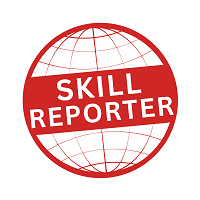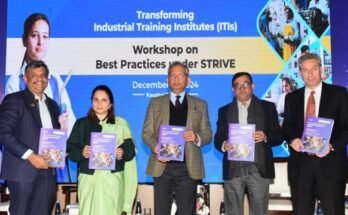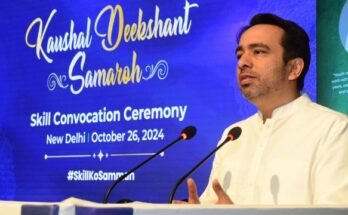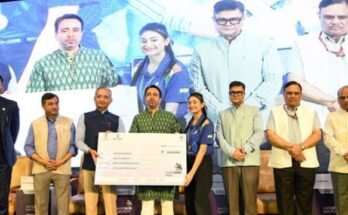New Delhi : In order to bring scale and speed to the Prime Minister’s Skill India Program, Shri Rajiv Pratap Rudy, Minister of State (Independent Charge) for Skill Development and Entrepreneurship (MSDE), today announced the extensive use of modern technology and digital solutions in skill trainings that the youth will experience across the nation, very soon. He said this while inaugurating the Skill India Pavilion at the India International Trade Fair (IITF), today at Pragati Maidan in New Delhi.
The pavilion following the theme of Digital India showcases an array of interactive and digital solutions and make skills more aspirational for the youth. Select priority sectors of Skill India like Automotive, IT, Construction, Telecom, Furniture and furnishings, Plumbing, displayed digital initiatives to showcase how they are using modern technology to give hands-on training to candidates.
Addressing the gathering at the Pavilion, Shri Rudy said, “Our National Policy for Skill Development and Entrepreneurship, 2015 envisages to, leverage modern technology to ensure scale, access and outreach in skill training, along with bringing about ease in delivering content and monitoring results. Hence to scale up our endeavors, we are soon introducing digital, virtual and augmented reality based solutions that will bring scale, speed with standards to our ecosystem. The use of digital solutions like these increases the learning absorption capacity of individuals to a tune of 12 times.”
“IITF is a great platform for us to engage with the youth of our country. I call upon everyone to come and experience how advance technological solutions are being integrated in skill training in our country today to ensure that we meet world class requirements and standards,” he further added.
The pavilion has interesting and interactive solutions which can be tried out by youth at the venue itself like Motor Dexterity set up by Maruti to test motor skills of a person, welding simulators where one can get immediate results on their welding skills, interactive mobile solutions that will teach you how to repair parts of a mobile, gesture games, interactive panels and digital display mapping the entire skill ecosystem. Visitors were also seen signing up for the #ISupportSkillIndia campaign showcasing their commitment to promote skills which is crucial for the growth of India’s economy and its youth.
With a target of skilling and providing sustainable livelihood to more than 40 million by 2022, there is an urgent need to utilize technology for increasing the quality of skilling as well as expanding the outreach. The Ministry of Skill Development & Entrepreneurship (MSDE) has taken multiple initiatives to enable the use of technology in its skill development efforts.
Through a special fund for innovation, MSDE through NSDC has also propagated early stage companies and social entrepreneurs to take up critical challenges in the ecosystem that could be addressed with the use of technology and with appropriate integration into the skilling ecosystem. Some of the funded innovations include use of an online lending model (‘crowdfunding’), artificial intelligence to scan potential candidates, augmented reality applications on mobile phones for self-learning environments, etc.
Shri Rudy stated that according to a World Bank study there a threat that automation is set to impact almost 69 percent of the jobs in India, hence there is a need to consider the future of jobs and employment in the country along with up-gradation of our human resource with modern technological skills wherever possible.
The Ministry emphasizes on the use of Virtual and Augmented reality (VR/AR) which has direct application in multiple industries like gaming, entertainment, architecture, construction, oil & gas, aviation, automotive, etc. as they are increasingly and widely being used across industries for training the workforce. Developing a VR/AR ready workforce in India is important at multiple levels.
Shri Rudy further added “These technologies have less differentiation from an education standpoint, which will make them easy to adapt. This is quite relevant to the target population that the Skill India Mission is targeting – school drop-outs, adolescent girls, rural youth from disadvantaged geographies and social groups, people with disabilities etc. There is enough evidence to suggest that the cognitive power of children and youth in India could be limited due to widespread malnutrition and low learning outcomes of the primary education system. These technologies, when appropriately integrated, have the potential to break the entry-point barriers to access skilling.”
Skilling workforce in heavy equipment trades like aerospace, mining, offshore oil rig, telecommunications etc. is a challenging as the equipment and infrastructure required for such training are often expensive and thus conventional training environments are not particularly effective unless embedded in the work environment. With AR/VR, both these environments can be simulated in a small classroom.
In addition, finding efficient and equipped trainers to standardize the delivery of high-level training is also challenging. The use of such technology could also supplement the trainer’s capability to deliver training and help in the assessment as well – the candidate is assessed all through the training.



